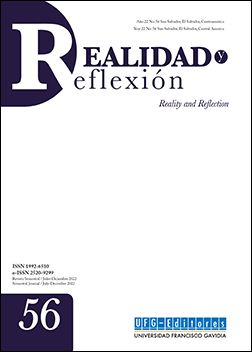El derecho a seguir en el clóset. Una aproximación desde la realidad latinoamericana
DOI:
https://doi.org/10.5377/ryr.v1i56.15774Palabras clave:
inclusión, diversidad, integridad, mentira, veracidadResumen
El objetivo del presente artículo es hacer una reflexión sobre la realidad que afrontan las personas de los diversos grupos de la diversidad sexual e identidad de género en países como México, cuando deciden reconocer su sexualidad de manera pública. A través de una aproximación a la realidad que vive el colectivo LGBTIQA, se busca analizar la crisis de derechos humanos que se da en la sociedad latinoamericana, encontrando puntos vinculantes entre esta situación y la propuesta teórica sobre la mentira propuesta por Sissela Bok. Como conclusión, se plantea la importancia de reconocer la individualidad de cada situación particular, misma que determina el nivel de riesgo y su posibilidad de calificarse como crisis.
Descargas
532
Descargas
Publicado
Cómo citar
Número
Sección
Licencia

Esta obra está bajo una licencia internacional Creative Commons Atribución-NoComercial-CompartirIgual 4.0.
© Universidad Francisco Gavidia (UFG)
Política de acceso abierto y derechos de autor
- El contenido y opiniones vertidas en cada contribución son responsabilidad de sus autores. Los autores ceden los derechos de edición y publicación, en versión impresa y digital, a la Universidad Francisco Gavidia.
- La revista Realidad y Reflexión es alojada en las plataformas institucionales de difusión, así como en bases de datos y otras páginas de divulgación científica.
- Las publicaciones de la Universidad Francisco Gavidia se acogen a la normativa salvadoreña de derechos de autor, contemplada en la Ley de Propiedad Intelectual https://wipolex-res.wipo.int/edocs/lexdocs/laws/es/sv/sv001es.pdf
- UFG Editores no realiza ningún cobro por postular, procesar, publicar o acceder a los aportes publicados; los miembros del Consejo Editorial y quienes conformen el Comité Científico en los número monográficos ejercen sus funciones con carácter Ad honorem.
- La revista Realidad y Reflexión opera bajo la modalidad de acceso abierto, a fin de agilizar la transferencia del conocimiento, disminuir la brecha de acceso a la información, incrementar la visibilidad, y, por lo tanto, la difusión de los aportes publicados.
- La revista declara su compromiso con el acceso abierto en la modalidad diamante, lo que significa que los lectores pueden acceder a todos los contenidos de manera gratuita y sin restricciones, y que los autores no deben asumir ningún costo de publicación o procesamiento de sus documentos.
- Las contribuciones pueden ser descargadas, utilizadas y distribuidas, atendiendo las condiciones de la licencia Creative Commons https://creativecommons.org/licenses/by-nc-sa/4.0/

